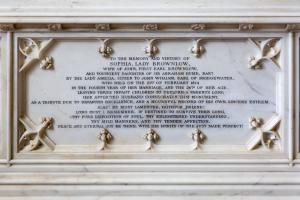Text this colour links to Pages. Text this colour links to Family Trees. Place the mouse over images to see a larger image. Click on paintings to see the painter's Biography Page. Mouse over links for a preview. Move the mouse off the painting or link to close the popup.
Antonio Canova 1757-1822 is in Sculptors.
In 1793 Richard Westmacott (age 17) travelled to Rome, Italy [Map] to study under Antonio Canova (age 35). Within a year of his arrival in Rome he won the first prize for sculpture offered by the Florentine academy of arts, and in the following year (1795) he gained the papal gold medal awarded by the Roman Academy of St Luke with his bas-relief of Joseph and his brethren.

After 21st February 1814. Monument to Amelia Sophia Hume (deceased) in St Peter and St Paul Church, Belton [Map]. Sculpted by Antonio Canova (age 56).
1817. George Hayter (age 24). Portrait of Antonio Canova (age 59).
Memorials of Francis Chantrey RA in Hallamshire and Elsewhere Part V London Life and Works. Montgomery, whose opinions I quote the more freely, not merely because he has himself looked upon sculpture with a poet's eye, but also because he oft endeavoured to excite a similar taste in his gifted friend-says, "Nothing in sculpture is truly excellent but that which is pre-eminently so, because nothing less than the most successful strokes of the happiest chisel can powerfully affect the spectator, fix him in dumb astonishment, touch his heart strings with tender emotion, stir thought from its depths into ardent and earnest exercise. I appeal to all who hear me, whether, among a hundred of the monuments in our cathedrals, and the statues in our public places, they ever met with more than one or two that laid hold of their imagination, so as to haunt it both in retirement and in society? "Such are the Apollo Belvidere, the Venus de Medici, and other inestimable relics of antiquity; such the Moses and David of Michael Angelo; and such- ( to give an English example worthy to be named with these, judging solely by the power which it exercises over the purest and most universal of human sympathies, -- sympathies which can no more be bribed by artifice than they can help yielding to the impulse of nature ) -such, I say, is the simple memorial by our own Chantrey (age 35), in Lichfield Cathedral [Map], of two children that were 'lovely in their lives, and in death are undivided. Of these specimens, it may be affirmed, that they have shown how the narrow bonds of vulgar precedent may be left as far behind as a star in the heavens leaves a meteor in the air."1 There is not, indeed, a more exquisite group in the whole range of modern sculpture than Chantrey's "Two Children" in marble. The sisters lie asleep in each others arms in the most unconstrained and graceful repose. The snowdrops which the youngest had plucked are undropped from her hand, and both are images of artless beauty, and innocent and unaffected race. Such was the press to see these children in the London Exhibition, that there was no getting near them: mothers, with tears in their eyes, lingered, and went away, and returned; while Canova's (age 59) now far-famed figures of Hebe and Terpsichore stood almost unnoticed by their side. Chantrey modelled two other figures of this class, viz., a "Sleeping Child," the daughter of Sir Thos. Dyke Acland; and a "Reposing Infant," for Mr. Boswell, of Auchinleck.
Note 1. "Lectures on Poetry," p. 20.
![]() Become a Member via our 'Buy Me a Coffee' page to read complete text.
Become a Member via our 'Buy Me a Coffee' page to read complete text.
In October 1817 John Gibson (age 27) travelled to Rome, Italy [Map] where he studied under Antonio Canova (age 59).
1819. John Jackson (age 40). Portrait of Antonio Canova (age 61).
In 1819 Francis Leggatt Chantrey (age 37) and John Jackson (age 40) travelled together to Italy. In Rome, Italy [Map] Chantrey met Antonio Canova (age 61).
In 1821 Richard James Wyatt (age 25) left England, and, after studying for a few months in Paris under Bosio, proceeded to Rome, and entered the studio of Antonio Canova (age 63), where he had John Gibson (1790–1866) as a fellow pupil.
In 1822 Joseph Gott (age 36) was sent to Rome on a pension from Sir Thomas Lawrence (age 52) who provided him with a personal letter of introduction to Antonio Canova (age 64). Gott remained in Rome for the rest of his life.
On 13th October 1822 Antonio Canova (age 64) died.